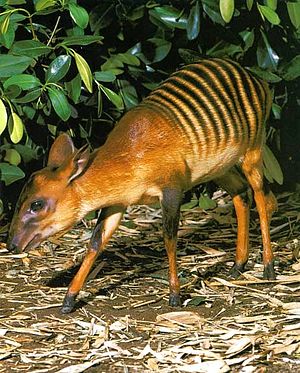Zebra sugar
| Zebra sugar | ||||||||||||
|---|---|---|---|---|---|---|---|---|---|---|---|---|

Zebra sugar ( Cephalophus zebra ) |
||||||||||||
| Systematics | ||||||||||||
|
||||||||||||
| Scientific name | ||||||||||||
| Cephalophus zebra | ||||||||||||
| ( Gray , 1838) |
The zebra duiker ( Cephalophus zebra ) is a small forest antelope, native to West Africa. Due to its strong differentiation from other duiker species , the monotypical species was placed in its own subgenus Cephalophula .
description
It reaches a shoulder height of 40 to 50 cm, a body length of 70 to 90 cm and a tail length of 10 to 15 cm. Its weight can reach 9-20 kg. The back is arched like the rest of the duckers and the body is stocky and muscular. The horns and legs are short. The hooves are spread apart. Both sexes have horns. Its fur is generally light orange in color. The black zebra-like pattern, which consists of twelve to fifteen stripes, is striking. These stripes run vertically from the back down the flanks. The underside as well as the back vary from white to almost black.
Way of life
Its habitat are primary forests with a closed canopy of leaves. It is mostly diurnal and lives shy and hidden in the dense undergrowth. His fur pattern merges in the shade of the undergrowth to form a perfect camouflage, so that he can hardly be made out. Its diet consists mainly of leaves and crops. Apparently he does not disdain animal food either. This is how zebra suckers got dead mice in the Frankfurt Zoo .
The gestation period is 221-229 days. Then a young animal is born. The young animals have a weight of approx. 1.8 kg at birth and a coat with a bluish tone. The characteristic stripes are already visible in the newborns, but are very close together. The newborns are nests and hide in one place in the thick undergrowth for two to three weeks. They are able to suckle just 30 minutes after birth and after 120 days they are weaned from their mother. After seven to nine months, the young animals are fully grown and have the same color as the adult animals. The males are sexually mature after two years.
Distribution area
The distribution area of the zebra duck is limited to a very small part of West Africa. He lives in the dense tropical rainforests of Ivory Coast , Guinea , Liberia and Sierra Leones .
Danger
The world population of zebra suckers is around 28,000 copies. It is endangered by the heavy deforestation of the primary forests and by hunting for its tasty meat. The main distribution areas are protected areas such as the two national parks in the Gola Forest in the border area of Sierra Leone and Liberia ( Gola Forest National Park and Gola Rainforest National Park ) or the Sapo National Park in southern Liberia.
literature
- Chris Stuart, Tilde Stuart: Field Guide to the Larger Mammals of Africa. 2nd edition. Struik, Cape Town 2000, ISBN 1-86872-534-0 .
Individual evidence
- ↑ Cephalophus zebra in the endangered Red List species the IUCN 2008. Posted by: Antelope Specialist Group, 2008. Accessed November 14, 2012th
Web links
- ultimateungulate.com - Zebra duiker (English)